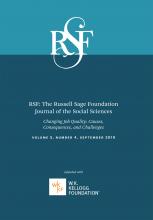Research Article
Open Access
Solidarity Within and Across Workplaces: How Cross-Workplace Coordination Affects Earnings Inequality
Nathan Wilmers
RSF: The Russell Sage Foundation Journal of the Social Sciences September 2019, 5 (4) 190-215; DOI: https://doi.org/10.7758/RSF.2019.5.4.07
Nathan Wilmers
aAssistant professor of work and organizational studies at the MIT Sloan School of Management

REFERENCES
- ↵
- Abowd, Paul
- ↵
- Alderson, Arthur S., and
- François Nielsen
- ↵
- Autor, David H
- ↵
- Autor, David H
- ↵
- ↵
- Autor, David H.,
- Lawrence F. Katz, and
- Melissa S. Kearney
- ↵
- Autor, David H.,
- Alan Manning, and
- Christopher L. Smith
- ↵
- Azar, José,
- Ioana Marinescu, and
- Marshall I Steinbaum
- ↵
- ↵
- ↵
- Benmelech, Efraim,
- Nittai Bergman, and
- Hyunseob Kim
- ↵
- Bernstein, Jared
- ↵
- ↵
- Bureau of Labor Statistics (BLS)
- ↵
- Bureau of Labor Statistics (BLS)
- ↵
- Card, David
- ↵
- Carpenter, Jesse T
- ↵
- Clark, Robert L.,
- Janemarie Mulvey, and
- Sylvester J. Schieber
- Clegg, Hugh A
- ↵
- ↵
- Cobb, J. Adam, and
- Ken-Hou Lin
- ↵
- Cobb, J. Adam, and
- Flannery G. Stevens
- ↵
- Cobble, Dorothy Sue
- ↵
- ↵
- ↵
- Dunlop, John T
- ↵
- ↵
- Fantasia, Rick
- ↵
- ↵
- Farber, Henry,
- Daniel Herbst,
- Ilyana Kuziemko, and
- Suresh Naidu
- ↵
- Fortin, Nicole M., and
- Thomas Lemieux
- ↵
- ↵
- Freeman, Richard B
- ↵
- ↵
- Goldin, Claudia, and
- Lawrence F. Katz
- ↵
- Goldin, Claudia, and
- Robert A. Margo
- ↵
- Gouldner, Alvin W
- ↵
- Handwerker, Elizabeth Weber
- ↵
- Hartman, Paul T.
- ↵
- Hibbs, Douglas A
- ↵
- Jacoby, Sanford M
- ↵
- Jacoby, Sanford M
- ↵
- Kalleberg, Arne L
- ↵
- ↵
- ↵
- Kochan, Thomas A.,
- Harry C. Katz, and
- Robert B. McKersie
- Kochan, Thomas A., and
- William Kimball
- ↵
- ↵
- Kopczuk, Wojciech,
- Emmanuel Saez, and
- Jae Song
- ↵
- Lee, David S
- ↵
- ↵
- Lemieux, Thomas,
- W. Bentley MacLeod, and
- Daniel Parent
- ↵
- Lester, Richard A
- ↵
- ↵
- Mizruchi, Mark S.
- ↵
- Moody, Kim
- ↵
- ↵
- Piketty, Thomas, and
- Emmanuel Saez
- ↵
- Piketty, Thomas,
- Emmanuel Saez, and
- Gabriel Zucman
- ↵
- Podolny, J. M
- ↵
- Powell, Walter
- ↵
- Rees, Albert
- ↵
- Reynolds, Lloyd G
- ↵
- Ross, Arthur
- ↵
- Shin, Taekjin
- ↵
- Slichter, Sumner H.,
- James J. Healy, and
- E. Robert Livernash
- ↵
- Song, Jae,
- David J. Price,
- Fatih Guvenen,
- Nicholas Bloom, and
- Till von Wachter
- ↵
- Starr, Evan,
- J. J. Prescott, and
- Norman Bishara
- ↵
- Stein, Judith
- ↵
- ↵
- VanHeuvelen, Tom
- ↵
- Viscelli, Steve
- ↵
- Wallerstein, Michael
- ↵
- Weil, David
- ↵
- Western, Bruce, and
- Jake Rosenfeld
- ↵
- ↵
- Whitford, Josh
- ↵
- Wilmers, Nathan
- ↵
- Wilmers, Nathan
- ↵
In this issue
Solidarity Within and Across Workplaces: How Cross-Workplace Coordination Affects Earnings Inequality
Nathan Wilmers
RSF: The Russell Sage Foundation Journal of the Social Sciences Sep 2019, 5 (4) 190-215; DOI: 10.7758/RSF.2019.5.4.07
Jump to section
- Article
- Abstract
- SOLIDARITY AND REGULATION AS SOURCES OF EQUALITY
- EARNINGS COORDINATION ACROSS WORKPLACES
- CONTROLLING FOR COMPETITIVE LABOR MARKET FORCES
- DATA
- INEQUALITY IN THE 1970S
- METHODS
- FINDINGS
- ROBUSTNESS CHECKS AND ALTERNATIVE EXPLANATIONS
- DEVELOPMENTS SINCE THE 1970S
- FUTURE RESEARCH
- CONCLUSION
- FOOTNOTES
- REFERENCES
- Figures & Data
- Info & Metrics
- References
Related Articles
- No related articles found.
Cited By...
- No citing articles found.





